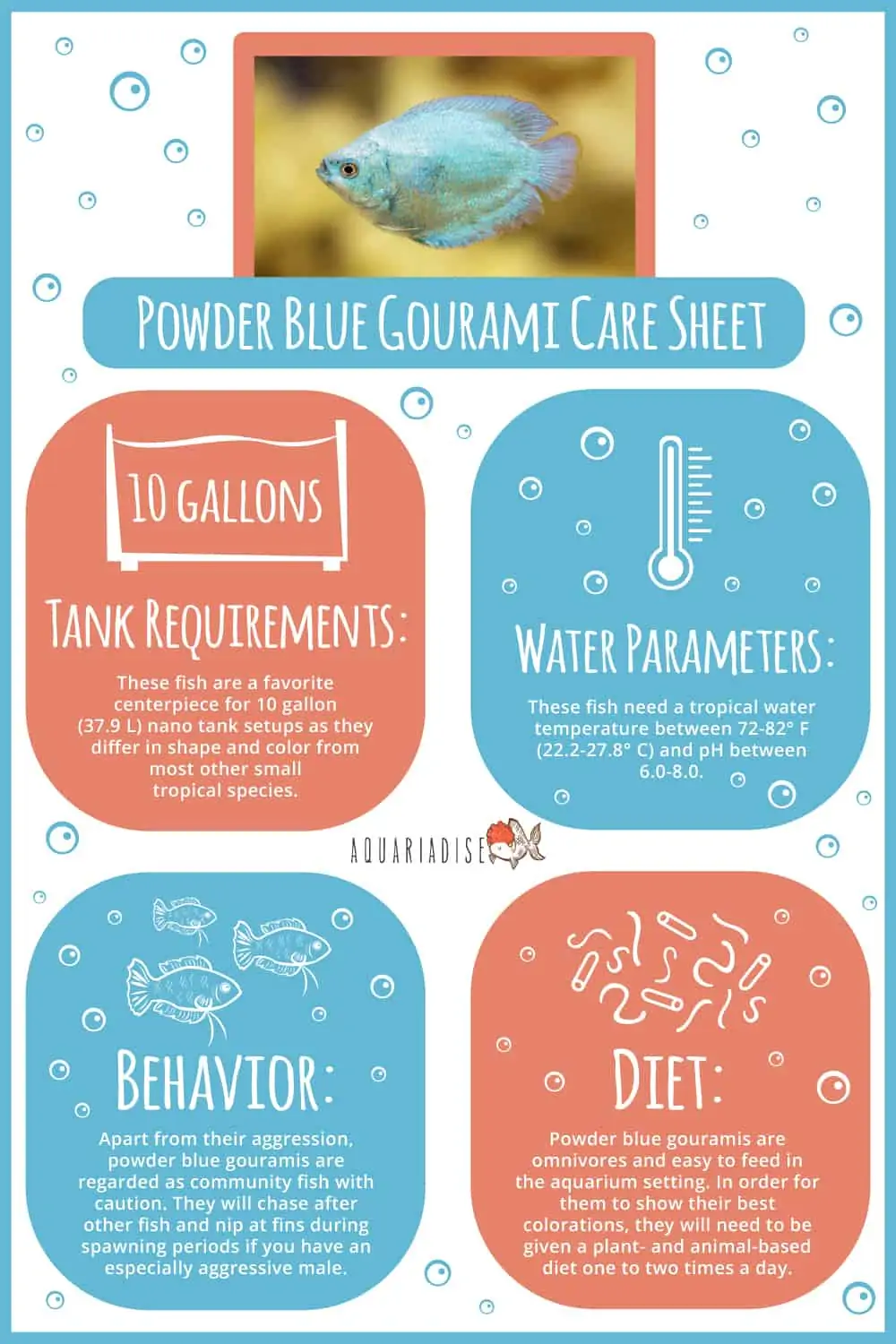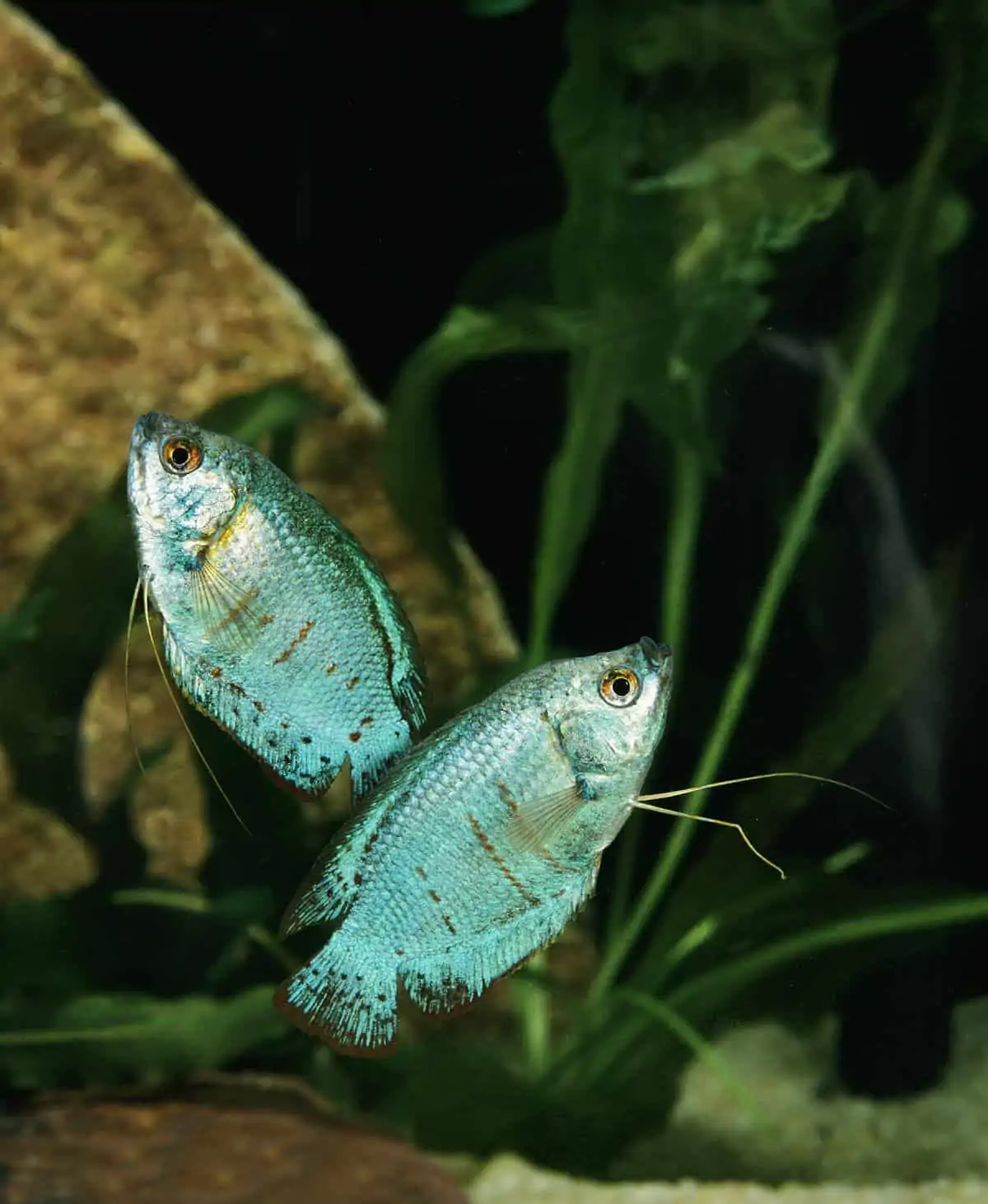The powder blue gourami is a very popular variation of the dwarf gourami due to its vibrant color and small size. These fish are relatively hardy and perfect for beginner and experienced hobbyists alike as they don’t need much space in the aquarium and have easy care requirements. While they are an easy species, it is still important to know how to give your powder blue gourami the best care possible so it has a happy and healthy life!
Keep reading to find out everything you need to know about the powder blue gourami and how to prepare your freshwater tank before getting one!

Name
Trichogaster lalia (formerly known as Colisa lalia) is commonly known as the dwarf gourami; these fish are also known as labyrinth fish due to their ability to breathe air from the surface of the water with their lung-like labyrinth organ, much like bettas can.
The powder blue gourami is a selectively-bred modification of Trichogaster lalia as a result of the aquarium hobby. These fish are named after their solid light blue bodies; however, because of intense breeding in the aquarium trade, most fish have some other colors or patterns across their bodies and are not truly solid.
Natural habitat
While the powder blue variation doesn’t exist in the wild, dwarf gouramis do originate from Asia. They are mainly found in slow-moving waters with dense vegetation, like ponds, streams, and lakes throughout Pakistan, India, and Bangladesh.
Because of their popularity and selectively-bred color variations, most fish are aquacultured and rarely harvested from the wild. As a result of this popularity in the home aquarium, populations have also been introduced through releases to outside ecosystems, like North America.
Identification
Dwarf gouramis are very similar to other full-sized Trichogaster sp., just smaller. They are usually most easily identifiable by their long, thread-like ventral fins located below the gills, which help the fish be more aware of its surroundings and to locate food.
Otherwise, powder blue dwarf gouramis can be identified by their steel-blue coloration, deep bodies, and broad fins; while exemplary powder blue gouramis will be one solid color, selective breeding has caused other colors and patterns to appear on these fish. It is not uncommon to see a powder blue dwarf gourami with some degree of crimson red stripes across its body.
How big do blue dwarf gouramis get?

So how big do dwarf gouramis actually get? On average, these fish grow to be 3-5 inches (7.6-12.7 cm) with the majority staying in the lower end of that range. These fish stay small and can live up to 5 years with exceptional care!
Looking for a gourami that grows a little bigger? Check out the incredible16-inch (40.6 cm) giant gourami!
How can you tell if a gourami is male or female?
In general, females are much smaller than males and not as colorful or as ornate. Most males also develop extended dorsal and anal fins as adults, which makes getting a breeding pair of powder blue gouramis relatively easy.
Powder blue gourami tank requirements
Powder blue gouramis are usually a perfect peaceful fish for a community tank setup. These fish are a favorite centerpiece for 10 gallon (37.9 L) nano tank setups as they differ in shape and color from most other small tropical species.
Dwarf gouramis can be shy fish and can actually be affected by the conditions outside of the tank, like loud noises or flashing lights. Because of this, it’s best to plan the placement of the tank as far away from possible stresses such as these. In addition, these fish will love lots of plants and caves to help imitate their natural environments; dark substrates will also help bring out the best colors possible of your fish.
Otherwise, these fish need a tropical water temperature between 72-82° F (22.2-27.8° C) and pH between 6.0-8.0. These fish come from slow-moving waters and are not the best swimmers in higher flow. They will appreciate plant coverage at the surface of the water in the form of duckweed or another floating species for added protection; most other freshwater plant species may also be used to cover the foreground, midground, and background of the aquarium.
Due to intensive breeding, these fish have suffered genetically and are more susceptible to freshwater fish diseases, like ich, flukes, and other parasites.
Powder blue gourami tank mates
While powder blue gouramis are good fish for beginners, they do require some consideration when selecting tank mates.
As these gouramis are shy, they should not be kept with more active, aggressive fish species that tend to nip at fins, like danios and guppies; some hobbyists have had luck keeping both danios and guppies together with dwarf gouramis, but it is very likely that their constant water surface activity will stress out your fish.
Instead, powder blue gouramis do best with slow, smaller fish that help bring out the best of their colors. Some potential powder blue gourami tank mates might be angelfish, rasboras, and some tetra species; gouramis do especially well with bottom-dwellers, like loaches, Corydoras, and Otocinclus, that stay out of the middle and upper water columns.
If you don’t want any additional fish with your dwarf gouramis, then an assortment of aquatic plants will look just as well and natural!
How many gouramis should be kept together?
By nature, dwarf gouramis are loose schooling fish, but most hobbyists like to keep them alone or in larger groups. Even then, many hobbyists have had a range of results with keeping groups of gourami versus keeping them by themselves.
Some hobbyists have likened dwarf gouramis to bettas in terms of aggression; different gourami species sometimes tend to be just as aggressive and territorial to each other as well as to the other community fish in the aquarium. Most hobbyists also have problems with keeping males from harassing females during spawning periods, even if the ratio is appropriate.
Others have had no problems keeping a small or large mix of gourami in the tank. It should be noted that these fish do tend to do better in larger tanks if planning to keep a school.
Do gouramis like to be in pairs?
Many aquarists keep these fish by themselves. It is believed that the males tend to do better alone while the females appreciate the company. If purchasing an already mated pair, then there should be little to no problems. However, if planning to buy an independent male and female, then there is a good chance that the male will become territorial and aggressive. In this case, it might be better to buy more females than males.
Powder blue gourami behavior
Apart from their aggression, powder blue gouramis are regarded as community fish with caution. These fish like to stay in the upper and middle water columns and are not overly active swimmers.
They will chase after other fish and nip at fins during spawning periods if you have an especially aggressive male.
Powder blue gourami diet
Powder blue gouramis are omnivores and easy to feed in the aquarium setting. In order for them to show their best colorations, they will need to be given a plant- and animal-based diet one to two times a day.
Dwarf gouramis fish will do best with a high-protein fish flake or pellet; these fish tend to stay towards the top of the tank so foods that float for a few seconds might be easier for your fish to eat. Otherwise, they can be given a variety of live, frozen, and freeze-dried foods, like bloodworms, brine shrimp, and mosquito larvae.
Because they are omnivores, they will also appreciate blanched vegetables, like zucchini and lettuce, every now and then as well as algae pellets/wafers. A healthy fish with a varied diet is sure to show its best coloration possible!
Breeding powder blue gourami

Dwarf gouramis are fascinating and relatively easy to breed in the aquarium hobby. Like betta fish, powder blues make bubble nests in order to breed and spawn. Because of the aggression of the male, it is strongly recommended to set up a separate breeding tank.
This breeding tank should be identical to the display aquarium in terms of water quality and temperature. Plants will be appreciated as males tend to use them for constructing the nest. Water current should be minimal as to not disturb the nest once the male has built it. A substrate is not needed, though either gravel or sand will work. If your mating pair doesn’t show signs of spawning, then try a succession of water changes while gradually increasing the water temperature.
Once conditions are right, the male will begin to build the nest at the surface of the water and become very aggressive to the female gourami. The fish will interlock and breed under the bubbles, leaving the fertilized eggs to float to the surface in the protection of the nest; the male will catch any that fail to rise and place them in the nest.
After all eggs have been fertilized, the female should be moved back to the main display as the male will take over caring for the nest and can become aggressive. The eggs should hatch within 36 hours depending on the water temperature and the nest will break apart once they have successfully hatched. The male may then also be moved back to the main display tank or left with the fry for a few more days.
The fry are very small and need to be fed small foods, like baby brine shrimp. They can eventually be moved to more substantial foods as they grow. In some cases, it is necessary to have multiple holding tank setups as the fry tend to grow at different rates, which can lead to bullying. Keep in mind that these fish can have up to 700 eggs at a time!
Conclusion
The powder blue is a very popular color variety of dwarf species of gourami. They are relatively easy to care for and are a popular choice for beginner hobbyists wanting a colorful and hardy fish. However, individuals can sometimes be aggressive, which can limit the other types of fish you can get for your aquarium, including other gouramis.
If keeping a pair of these fish, make sure to watch out for bubble nests at the surface of the water and changes in the male’s temperament. Also, have multiple tanks available as fry can grow at different rates!
If you have any questions about the powder blue gourami, other species of dwarf gourami, or have had experience breeding these gorgeous fish, don’t hesitate to leave a comment below!



When breeding gourami, is it best to turn off the filter and add an air stone to the twenty gallon tank to still the water?
Hi Karen!
This doesn’t matter too much. Turning off the filter is more important when the fry are free-swimming since they can easily get sucked up.
You look like a certain female YouTuber that I saw
Great info I would really appreciate info on how many female Powder Blue Gourami can fit in a16 gal tank with 2 albino guppies and can I have another small set of fish like ember tetras or rasboras?
Hi Mike!
I would only keep one gourami in the tank with a nice school of ember tetras or rasboras.
I am having a hard time identifying the sex of my powder blue dwarfs due to mixed information from multiple sources. Please help I have pictures!
Hey Ciera!
Gouramis can be difficult to sex. In general, the male will have a triangular point to the end of its dorsal fin while the female will have a rounded point to the end of its dorsal fin. The female will also have a rounder body overall. Feel free to send the pictures!